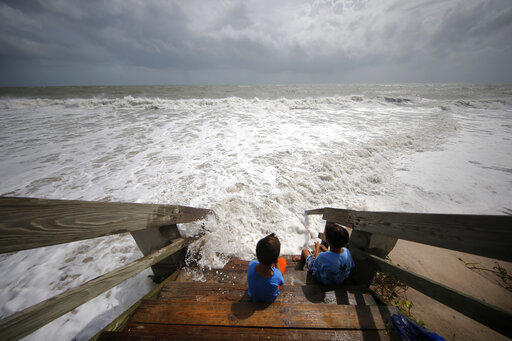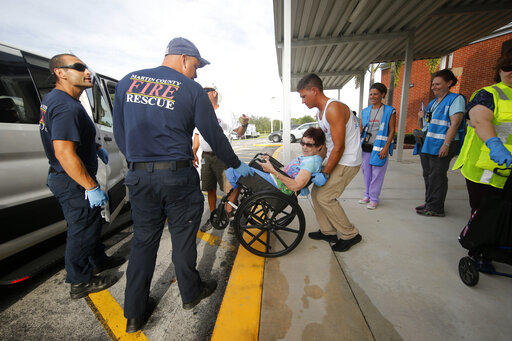Section Branding
Header Content
Officials Urge Georgians to Heed Warnings Ahead Of Hurricane Dorian
Primary Content
After ordering a mandatory evacuation of parts of six Georgia coastal counties, Gov. Brian Kemp and local officials are urging caution as Hurricane Dorian — now a Category 4 storm — approaches the coast of Florida.
Those living east of I-95 in Glynn, Chatham, Liberty, McIntosh, Bryan and Camden counties are ordered to evacuate effective noon Monday, according to the governor's office. Officials will also start contraflow of traffic on I-16 starting 8 a.m. Tuesday.
“If you are in these areas, please make arrangements to evacuate today," Sen. Johnny Isakson said. "This is a dangerous and powerful storm with the potential to bring damaging winds and catastrophic flooding to parts of Georgia."
Georgia state parks are open for evacuees and pets.
PREVIOUS COVERAGE: Kemp Orders Evacuations In Parts Of 6 Coastal Counties Ahead Of Hurricane Dorian
Kemp updated from Savannah at 11:20 a.m.
At noon, Kemp updated about ports:
Georgia Hurricane Resources:
- View up-to-date emergency declarations from Kemp here.
- View updates from Georgia Emergency Management and Homeland Security Agency here.
- Visit Ready Georgia for weather alerts and emergency preparedness tips.
- Follow Georgia 511 for real-time traffic information.
- Learn what to do before, during, and after a flood here.
- Report power outages by contacting your power provider. The two main providers in Georgia are:
- Call your local non-emergency police line to report a downed tree in a main road.
President Donald J. Trump on Sunday declared that an emergency exists in Georgia and ordered federal assistance to supplement state, tribal and local response efforts due to the emergency conditions resulting from Hurricane Dorian.
He authorized the Department of Homeland Security, Federal Emergency Management Agency, to coordinate all disaster relief efforts which have the purpose of alleviating the hardship and suffering caused by the emergency on the local population, and to provide appropriate assistance for required emergency measures, authorized under Title V of the Stafford Act, to save lives and to protect property and public health and safety, and to lessen or avert the threat of a catastrophe in in the counties of Brantley, Bryan, Camden, Charlton, Chatham, Effingham, Glynn, Liberty, Long, McIntosh, Pierce, and Wayne.
Specifically, FEMA is authorized to identify, mobilize, and provide at its discretion, equipment and resources necessary to alleviate the impacts of the emergency. Emergency protective measures, limited to direct Federal assistance, will be provided at 75% federal funding.
Schools along the coast have begun to announce closures as Dorian approaches. The storm is expected to move north along the coast, and Georgia could begin experiencing tropical storm-force winds Tuesday.
MORE: Coastal Georgia Schools Close Ahead Of Hurricane Dorian
The Savannah-Chatham County and Camden County school districts will both be closed Tuesday and Wednesday.
Dorian kept pounding at the northern Bahamas early Monday, as one of the strongest Atlantic storms ever recorded left wrecked homes, shredded roofs, tumbled cars and toppled power poles in its wake.
The storm's top sustained winds decreased slightly to 165 mph (270 kph) as its westward movement slowed, crawling along Grand Bahama island Monday morning at 1 mph (2 kph) in what forecasters said would be a daylong assault. Earlier, Dorian churned over Abaco island with battering winds and surf during Sunday.
Information began emerging from the affected islands, with Bahamas Power and Light saying there is a total blackout in New Providence, the archipelago's most populous island.
"The reports out of Abaco (island) as everyone knows," company spokesman Quincy Parker told ZNS Bahamas radio station, "were not good."
Most people went to shelters as the Category 5 storm approached, with tourist hotels shutting down and residents boarded up their homes. But many people were expected to be left homeless.
"It's devastating," Joy Jibrilu, director general of the Bahamas' Ministry of Tourism and Aviation, said Sunday afternoon. "There has been huge damage to property and infrastructure. Luckily, no loss of life reported."
On Sunday, Dorian's maximum sustained winds reached 185 mph (297 kph), with gusts up to 220 mph (354 kph), tying the record for the most powerful Atlantic hurricane to ever make landfall. That equaled the Labor Day hurricane of 1935, before storms were named. The only recorded storm that was more powerful was Hurricane Allen in 1980, with 190 mph (305 kph) winds, though it did not make landfall at that strength.
Forecasters said Dorian was most likely to begin pulling away from the Bahamas early Tuesday and curving to the northeast parallel to the U.S. Southeast seaboard. Still, the potent storm was expected to stay close to shore and hammer the coast with dangerous winds and heavy surf, while authorities cautioned that it could still make landfall.
According to a Monday morning advisory from the U.S. National Hurricane Center in Miami, the storm was virtually parked over Grand Bahama island, which was in for a "prolonged period of catastrophic winds and storm surge" though the night. It also said Florida's east-central coast may see a brief tornado sometime between Monday afternoon and Monday night.
South Carolina Gov. Henry McMaster issued an order Sunday for the mandatory evacuation of his state's entire coast. The order, which covers about 830,000 people, was to take effect at noon Monday, at which point state troopers were to make all lanes on major coastal highways one-way heading inland.
"We can't make everybody happy, but we believe we can keep everyone alive," McMaster said.
A few hours later, Georgia's governor, Brian Kemp, ordered mandatory evacuations for that state's Atlantic coast, also starting at midday Monday.
Authorities in Florida ordered mandatory evacuations in some vulnerable coastal areas. North Carolina Gov. Roy Cooper warned his state that it could see heavy rain, winds and floods later in the week.
Dorian first came ashore Sunday at Elbow Cay in Abaco island at 12:40 p.m., then made a second landfall near Marsh Harbour at 2 p.m.
"Catastrophic conditions" were reported in Abaco, with a storm surge of 18 to 23 feet (5.5-7 meters).
Video that Jibrilu and government spokesman Kevin Harris said was sent by Abaco residents showed homes missing parts of roofs, electric lines on the ground and smashed and overturned cars. One showed floodwaters rushing through the streets of an unidentified town at nearly the height of a car roof.
In some parts of Abaco, "you cannot tell the difference as to the beginning of the street versus where the ocean begins," Prime Minister Hubert Minnis said. According to the Nassau Guardian, he called it "probably the most sad and worst day of my life to address the Bahamian people."
Bahamas radio station ZNS Bahamas reported that a mother and child on Grand Bahama had called to say they were sheltering in a closet and seeking help from police.
Silbert Mills, owner of the Bahamas Christian Network, said trees and power lines were torn down in Abaco.
"The winds are howling like we've never, ever experienced before," said Mills, who was riding out the hurricane with his family in the concrete home he built 41 years ago on central Abaco.
Jack Pittard, a 76-year-old American who has visited the Bahamas for 40 years, also decided to stay put on Abaco for Dorian, which he said was his first hurricane. A short video from Pittard about 2:30 p.m. Sunday showed the wind shaking his home and ripping off the siding.
The Bahamas archipelago is no stranger to hurricanes. Homes are required to have metal reinforcements for roof beams to withstand winds into the upper limits of a Category 4 hurricane, and compliance is generally tight for those who can afford it. Risks are higher in poorer neighborhoods, with wooden homes in low-lying areas.
On Tuesday and Wednesday, Dorian is forecast to be 40 to 50 miles (64 to 80 kilometers) off Florida, with hurricane-force wind speeds extending about 35 miles (56 kilometers) to the west.
The U.S. National Hurricane Center issued a hurricane watch for Florida's East Coast from Deerfield Beach north to the Georgia state line. The same area was put under a storm surge watch. Lake Okeechobee was under a tropical storm watch.
Mandatory evacuation orders for low-lying and flood-prone areas and mobile homes were in effect starting either Sunday or Monday from Palm Beach County north to at least the Daytona Beach area, and some counties to the north issued voluntary evacuation notices. Weekend traffic was light in Florida despite those orders, unlike during the chaotic run-up to Hurricane Irma in 2017 when the unusually broad storm menaced the entire state.
Ken Graham, director of the hurricane center, urged people not to bet on safety just because the forecast track had the storm a bit offshore. With every new forecast, "we keep nudging (Dorian's track) a little bit to the left" — that is, is closer to the Florida coast, Graham said.
President Donald Trump already declared a state of emergency and was briefed about what he called a "monstrous" storm.
"We don't know where it's going to hit but we have an idea, probably a little bit different than the original course," Trump said. "But it can change its course again and it can go back more toward Florida."
<!-- The following message will be displayed to users with unsupported browsers: -->Your browser does not support the <code>iframe</code> HTML tag. Try viewing this in a modern browser like Chrome, Safari, Firefox or Internet Explorer 9 or later.




